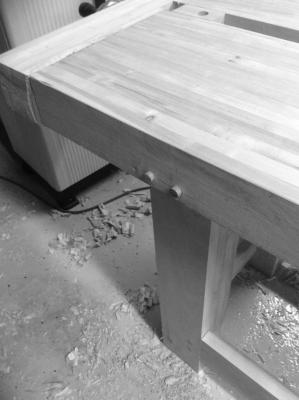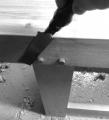Pinning the Legs
Primary tabs
 After I cut the opening for the wagon vise on the top of the bench, and spent the time to get the leg mortises sized correctly on the bottom of the bench, I debated whether to glue the legs, or pin the legs, or leave them as they are. In the fitting, I had to pound quite hard to get the legs to seat in the benchtop mortises. I figured it was going to be near-on impossible to pull it apart without rigging up a rope and pulley system of some sort. Still, I also know that working on this thing will involve lots of pounding, and Murphy being who he is, it will eventually start working loose. So I needed to reinforce the connection without having to pull it apart first. Pins it is.
After I cut the opening for the wagon vise on the top of the bench, and spent the time to get the leg mortises sized correctly on the bottom of the bench, I debated whether to glue the legs, or pin the legs, or leave them as they are. In the fitting, I had to pound quite hard to get the legs to seat in the benchtop mortises. I figured it was going to be near-on impossible to pull it apart without rigging up a rope and pulley system of some sort. Still, I also know that working on this thing will involve lots of pounding, and Murphy being who he is, it will eventually start working loose. So I needed to reinforce the connection without having to pull it apart first. Pins it is.
I bought some 3/8" diameter oak dowels, drilled two holes in the front and back face of the bench where the leg sits in it's mortise, and then glued and drove home the dowels. The drilling was the tricky part here. I wanted the face of the hole to be clean, so I used a 3/8" forstner bit to start the holes, but I don't have a forstner bit long enough to go in deep enough to drill through to the other side of the leg's tenon. (I wanted to make sure the pin was seated in the benchtop wood on both sides of the leg.) So after starting the holes, I realized I needed a really long 3/8" drill bit. So off to Lowes I went. I bought several of those really long auger type bits commonly used in constuction.
Here's a note on those auger bits. They are nominally the size stated, but . . . they really hog out the wood and try to rip your arm off if your using a strong drill. All of that's good. What's not so good is that they rush through and the resulting hole ends up being a bit of a mess. And that mess is not really 3/8" wide. I went up and down in the hole with the auger bit (since it's the only thing I have that's long enough to reach the full depth. But once cut, that hole really doesn't get much wider than that first pass.
So this meant when driving the pegs, they got stuck just past the depth of the forstner-bit drilled hole. Out came my trusty LN block plane, and I planed down each of the dowels so it would drive all the way to the bottom of each hole. (No, I didn't have green wood pegs a la Christopher Schwartz, and anyway, doing that with offset drill holes in the legs for a drawbore effect . . . that would have involved me separating the legs from the top again. See paragraph 1 above for why *that* wasn't going to happen. So hard, dry pegs, slightly tapered by a block plane. A little glue, and then drving them home. Boy, that was a satisfying feeling!
 Then with the little Stanley flush-cut saw, I trimmed the pegs to sit flush with the bench face. A couple of passes with the block plane, and it's done.
Then with the little Stanley flush-cut saw, I trimmed the pegs to sit flush with the bench face. A couple of passes with the block plane, and it's done.
No, I'm never going to break down this bench when moving it, but I'd like an honest answer from those who have built their's to be taken apart. How many times have you actually done it?
Yeah, I thought not.

